Globe GC-1 Swift
The Globe GC-1 Swift, also known as the Globe/Temco Swift, is a light, two-seat sport monoplane from the post-World War II period.
| GC-1 Swift | |
|---|---|
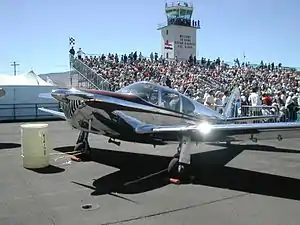 | |
| Globe Swift | |
| Role | Civil aircraft |
| Manufacturer | Globe Aircraft/TEMCO |
| Designer | R.S. Johnson |
| First flight | GC-1A Swift: 1942 |
| Introduction | 1946 |
| Number built | 1,521 (including prototypes)[1] |
| Developed from | Culver Cadet |
| Developed into | T-35 Buckaroo |
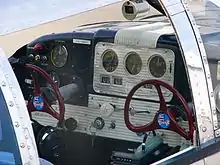

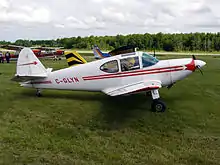
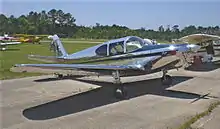
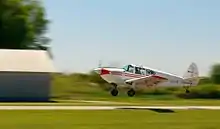
Design and development
The Swift was designed by R.S. "Pop" Johnson in 1940, despite the fanciful story which has now entered into popular mythology surrounding the Swift's origins, that a Culver Cadet was obtained as a "template" aircraft.[2] The design was financially secured by John Kennedy, president of the Globe Medicine Company, to be built by his new Globe Aircraft Company. World War II interrupted their plans, however, and the 85 hp (63 kW) GC-1A Swift advertised as the "All Metal Swift" re-designed by K.H."Bud" Knox, received its type certificate on 7 May 1946. Two prototypes were built but essentially, the design remained the same as the type entered production.[3] Globe built about 408 GC-1As.
Later that year, the Swift received a more powerful engine of 125 hp (93 kW), making it the GC-1B. Globe, together with TEMCO, built 833 GC-1Bs in six months. Globe's production outpaced sales of the Swift; as a result Globe was forced into insolvency. TEMCO, the largest debtor, paid $328,000 to obtain the type certificate, tooling, aircraft, and parts allowing them to continue production in late 1947 hoping to recoup their losses.[4] TEMCO built 260 more aircraft before ending Swift production in 1951.
The type certificate for the Swift was obtained by Universal Aircraft Industries (later Univair) along with all production tooling. Spare parts continued to be built until 1979 when the Swift Museum Foundation under the leadership of President Charlie Nelson purchased the Type Certificate, parts and tooling.[1]
Operational history
The most unusual variant of the series became a separate design, the TEMCO TE-1 Buckaroo which was built in a short-run first as a contender for a USAF trainer aircraft contract, and was later transferred to foreign service as a military trainer.[5] Several of these trainers have since returned to the civil market.
Specifications (GC-1B)
Data from Flugzeuginfo.net[6] Type Certificate Data Sheet No. A-766 [7] & The Incomplete Guide to Airfoil Usage[8]
General characteristics
- Crew: one
- Capacity: one passenger
- Length: 20 ft 10 in (6.35 m)
- Wingspan: 29 ft 4 in (8.94 m)
- Height: 6 ft 2 in (1.88 m)
- Wing area: 132 sq ft (12.3 m2)
- Airfoil: Root NACA 23015, Tip NACA 23009
- Empty weight: 1,370 lb (621 kg)
- Gross weight: 1,710 lb (776 kg)
- Powerplant: 1 × Continental C125 six cylinder, four-stroke aircraft engine, 125 hp (93 kW)
Performance
- Cruise speed: 122 kn (140 mph, 226 km/h)
- Never exceed speed: 161 kn (185 mph, 298 km/h)
- Range: 1,000 nmi (1,200 mi, 1,900 km)
- Service ceiling: 18,000 ft (5,500 m)
- Rate of climb: 700 ft/min (3.6 m/s)
See also
Aircraft of comparable role, configuration, and era
References
- Notes
- Davisson 1983, p. 71.
- Davisson 1983, p. 67.
- Davisson 1983, p. 69.
- Aviation News volume 7. 1947. Missing or empty
|title=(help) - Davisson 1983, p. 70.
- "GC-1 Swift." flugzeuginfo.net. Retrieved: April 17, 2010.
- "Type Certificate Data Sheet No. A-766." airweb.faa.gov. Retrieved: April 17, 2010.
- Lednicer, David. "The Incomplete Guide to Airfoil Usage." ae.uiuc.edu, October 2007. Retrieved: April 17, 2010.
- Bibliography
- Davisson, Budd. "Swiftly, Swiftly: An Appreciation of one of General Aviation's Classic Aircraft." Air Progress, Vol. 45, No. 8, August 1983.
- Lert, Peter. "In The Air: Used Singles Guide." Air Progress, Vol. 48, No. 7, July 1986.
External links
| Wikimedia Commons has media related to Globe Swift. |
